NCERT Solutions for Class 8 Science Chapter 13 - Light
Q1: Suppose you are in a dark room. Can you see objects in the room? Can you see objects outside the room? Explain.
Ans: If a person is inside a room where there is no light, it is then impossible to see the object inside the room, but the object outside the room can be seen easily.
When light falls on the eyes after reflecting from the object, it becomes visible. If the room is dark, then the object which is in the room reflects no light. Hence, the person is not able to see the objects in the room where there is no light.
Q2: Differentiate between regular and diffused reflection. Does diffused reflection mean the failure of the laws of reflection?
Ans:
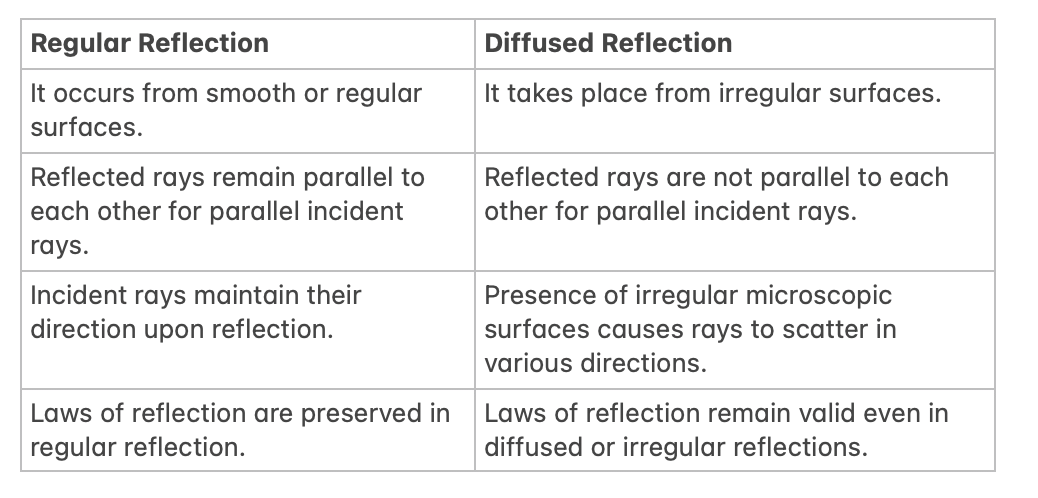

Q3: Mention against each of the following whether regular or diffused reflection will take place when a beam of light strikes. Justify your answer in each case.
(a) Polished wooden table
(b) Chalk powder
(c) Cardboard surface
(d) Marble floor with water spread over it
(e) Mirror
(f) Piece of paper
Ans:
(a) Polished wooden table: Regular reflection
Sol: A polished surface is an example of a smooth surface. A polished wooden table has a smooth surface. Hence, reflections from the polished table will be regular.
(b) Chalk powder: Diffused reflection
Sol: Chalk powder spread on a surface is an example of an irregular surface. It is not smooth. Therefore, the diffused reflection will take place from chalk powder.
(c) Cardboard surface: Diffused reflection
Sol: The cardboard surface is also an example of an irregular surface. Hence, the diffused reflection will take place from a cardboard surface.
(d) Marble floor with water spread over it: Regular reflection
Sol: A marble floor with water spread over it is an example of a regular surface. This is because water makes the marble surface smooth. Hence, the regular reflection will take place from this surface.
(e) Mirror: Regular reflection
Sol: Mirror has a smooth surface. Therefore, it will give a regular reflection.
(f) Piece of paper: Diffused reflection
Sol: Although a piece of paper may look smooth, but it has many irregularities on its surface. Due to this reason, it will give a diffused reflection.
Q4: State the laws of reflection.
Ans: Laws of reflection:
- The angle of reflection is always equal to the angle of incidence.
- The incident ray, the reflected ray and the normal to the reflective surface at the point of incidence all lie in the same plane.

Q5: Describe an activity to show that the incident ray, the reflected ray and the normal at the point of incidence lie in the same plane.
Ans:
- Place a plane mirror on the table.
- Take a paper sheet and create a small hole in its center.
- Ensure the room lighting is not too bright.
- Hold the sheet perpendicular to the table.
- Place another sheet on the table touching the vertical mirror.
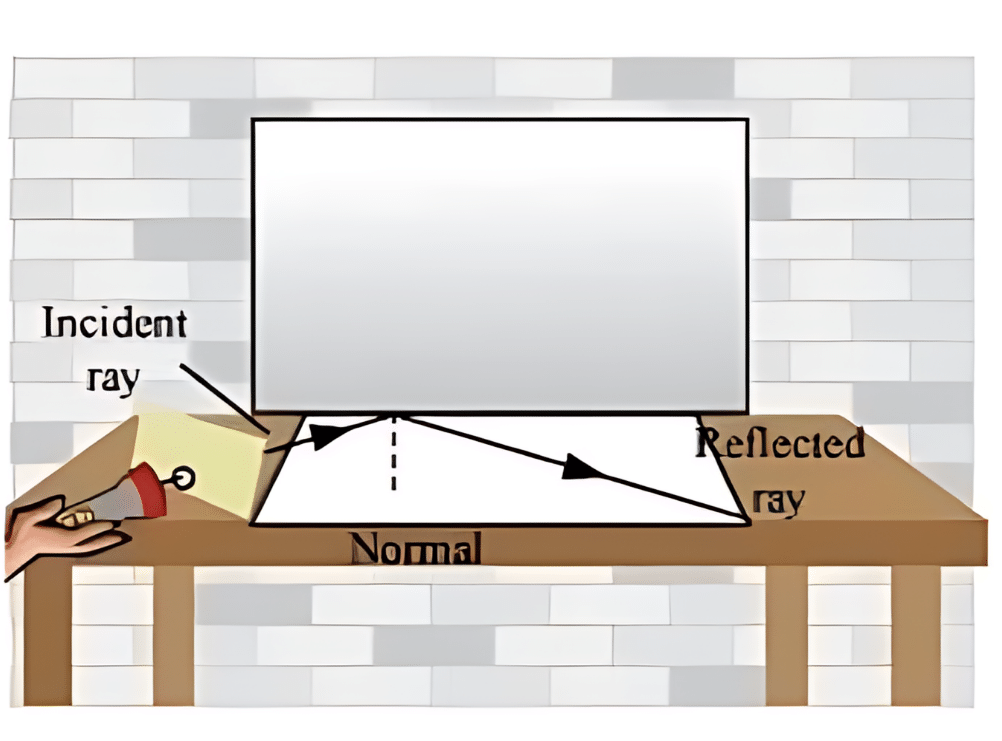
- Draw a normal line on the second sheet from the mirror.
- Shine a torch on the mirror through the small hole, directing the light ray onto the normal at the mirror's bottom.
- When the light ray hits the mirror, it reflects in a specific direction.
- Observe the incident ray, reflected ray, and normal line at the point of incidence on the sheet.
- Note that the incident ray, reflected ray, and normal line all lie in the same plane, demonstrating the principle of reflection.
Q6. Fill in the blanks in the following.
(a) A person 1 m in front of a plane mirror seems to be ______ m away from his image.
(b) If you touch your ________ ear with your right hand in front of a plane mirror, it will be seen in the mirror that your right ear is touched with your _________.
(c) The size of the pupil becomes ________ when you see in dim light.
(d) Night birds have _________ cones than rods in their eyes.
Ans:
(a) A person 1 m in front of a plane mirror seems to be 2 m away from his image.
Sol: Object distance and image distance are the same from a plane mirror. The image of a person 1 m in front of a mirror is 1 m back to the mirror. Hence, the image is 1 + 1 = 2 m away from the person.
(b) If you touch your left ear with your right hand in front of a plane mirror, it will be seen in the mirror that your right ear is touched with your left hand
Sol: This is because of lateral inversion of images formed in a plane mirror.
(c) The size of the pupil becomes large when you see in dim light.
Sol: In dim light, the amount of light entering the eye is very little. To increase the amount of light, the pupil expands.
(d) Night birds have less cones than rods in their eyes.
Sol: Night birds can see in the night, but not in the day. They have on their retina a large number of rod cells and only a few cones.
Q7: Angle of incidence is equal to the angle of reflection.
(a) Always
(b) Sometimes
(c) Under special conditions
(d) Never
Ans: (a)
Sol: The angle of incidence is always equal to the angle of reflection. This is the first law of reflection.
Q8: Image formed by a plane mirror is
(a) virtual, behind the mirror and enlarged.
(b) virtual, behind the mirror and of the same size as the object.
(c) real at the surface of the mirror and enlarged.
(d) real, behind the mirror and of the same size as the object.
Ans: (b)
Sol: Image formed by a plane mirror is virtual, behind the mirror and of the same size as the object. The image formed by a plane mirror is of the same size as the object. The image is formed behind the mirror. The image cannot be obtained on a screen. Hence, it is a virtual image.
Q9: Describe the construction of a kaleidoscope.
Ans: To construct kaleidoscope:
- Take three rectangular mirror strips, each about 15 cm long and 4 cm wide.
- Join the mirror strips together to form a prism shape.
- Secure the mirror prism inside circular cardboard tubes or tubes made of thick chart paper.
- Ensure the tube is slightly longer than the mirror strips.
- Close one end of the tube with a cardboard disc that has a hole in the center for viewing.

- Reinforce the cardboard disc by pasting a piece of transparent plastic sheet underneath.
- On the other end of the tube, which touches the mirrors, attach a circular plane glass plate.
- Place several small broken pieces of colored glass on the glass plate.
- Close this end with another round glass plate, leaving enough space for the colored glass pieces to move freely.
Q10: Draw a labelled sketch of the human eye.
Ans: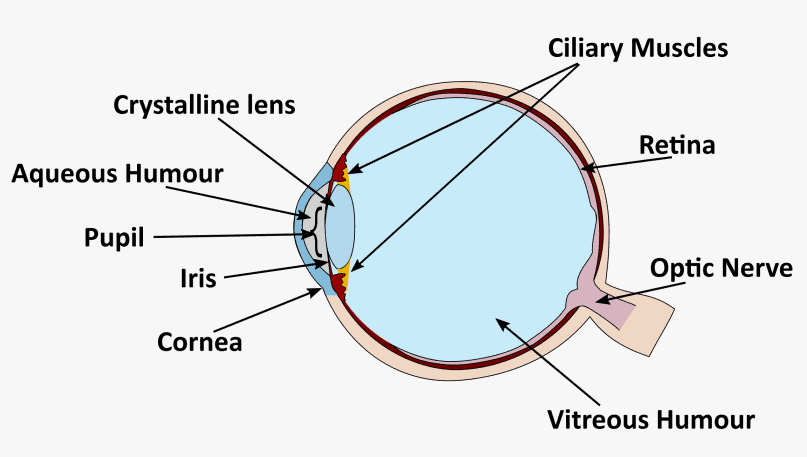 Human Eye
Human Eye
Q11: Gurmit wanted to perform Activity 16.8 using a laser torch. Her teacher advised her not to do so. Can you explain the basis of the teacher’s advice?
Ans: Laser light is harmful to the human eyes because its intensity is very high. It can cause damage to the retina and lead to blindness. Hence, it is advisable not to look at a laser beam directly.
Q12: Explain how you can take care of your eyes.
Ans: To protect our eyes, the given points should be taken into account:
- Visit an eye specialist regularly.
- Avoid reading in dim light and very bright light.
- Avoid direct exposure to sunlight to the eye.
- Clean your eyes with cold water quickly if dust particles or small insects enter your eye. Do
- not rub your eyes.
- Maintain a distance of at least 25 cm between the book and your eyes while reading.
Q13: What is the angle of incidence of a ray if the reflected ray is at an angle of 90° to the incident ray?
Ans: 
We know that angle of incident ray is equal to angle of reflected ray i.e. ∠i = ∠r
Here, it is given that ∠i + ∠r = 90°
⇒ ∠i + ∠i = 90°
⇒ 2∠i = 90°
⇒ ∠i = 45°
Q14: How many images of a candle will be formed if it is placed between two parallel plane mirrors separated by 40 cm?
Ans: Infinite or multiple images of the candle will be formed because of multiple reflections between the mirrors. When two mirrors are placed parallel to each other, then infinite numbers of images are formed.
Q15: Two mirrors meet at right angles. A ray of light is incident on one at an angle of 30° as shown in Fig. Draw the reflected ray from the second mirror.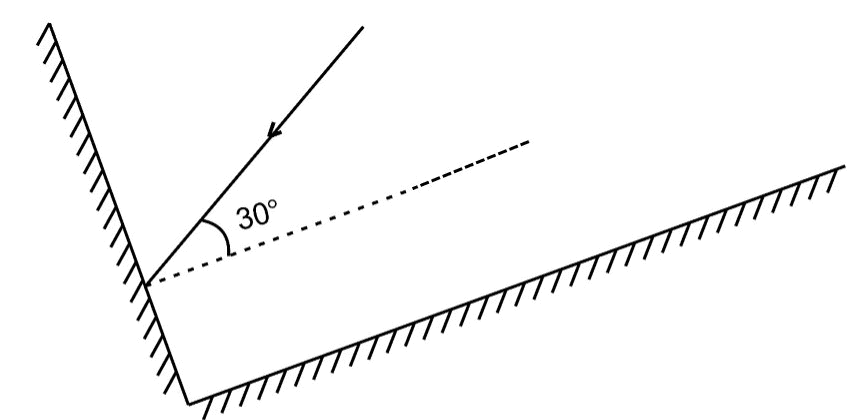 Ans: The first law of reflection is used to obtain the path of reflected light.
Ans: The first law of reflection is used to obtain the path of reflected light.
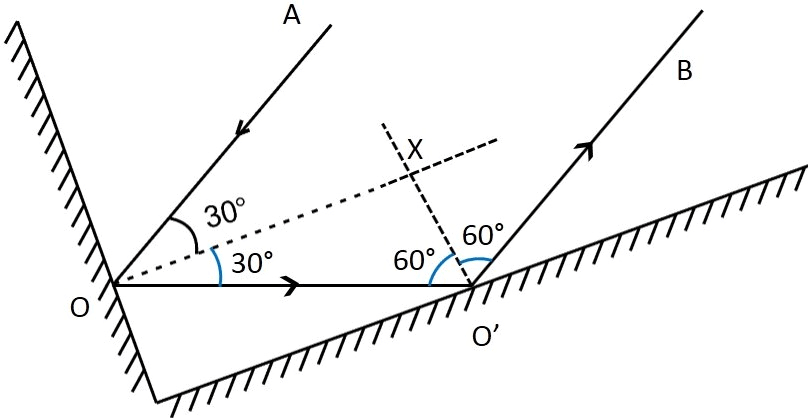 It can be observed that the given ray of light will reflect from the second mirror at an angle 60°.
It can be observed that the given ray of light will reflect from the second mirror at an angle 60°.
Q16: Boojho stands at A just on the side of a plane mirror as shown in Fig. 16.20. Can he see himself in the mirror? Also, can he see the image of objects situated at P, Q and R?
Ans: A plane mirror forms a virtual image behind the mirror. The image is as far behind the mirror as the object is in front of it. A cannot see his image because the length of the mirror is too short on his side. However, he can see the objects placed at points P and Q, but cannot see the object placed at point R (as shown in the given figure).
 Q17: (a) Find out the position of the image of an object situated at A in the plane mirror (Fig).
Q17: (a) Find out the position of the image of an object situated at A in the plane mirror (Fig).
(b) Can Paheli at B see this image?
(c) Can Boojho at C see this image?
(d) When Paheli moves from B to C, where does the image of A move?
Ans: (a) Image of the object placed at A is formed behind the mirror. The distance of the image from the mirror is equal to the distance of A from the mirror. Image of A is shown in the given figure. (b) Yes. Paheli at B can see this image.
(b) Yes. Paheli at B can see this image.
(c) Yes. Boojho at C can see this image.
(d) If we trace the reflected rays from B and C backwards, they converge at a point behind the mirror. The position of image A remains fixed even if Paheli moves.
|
90 videos|296 docs|44 tests
|
FAQs on NCERT Solutions for Class 8 Science Chapter 13 - Light
| 1. What is light according to Class 8 NCERT Solutions? |  |
| 2. How does light help us see objects? |  |
| 3. What is the speed of light? |  |
| 4. How does light interact with different materials? |  |
| 5. How is light important in our daily lives? |  |

















